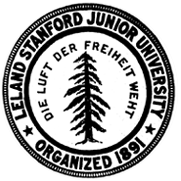History
Stanford's identity marks have a rich history.
El Palo Alto: the Tree
In November of 1769, Gaspar de Portola and his party camped under a towering double redwood tree located on the bank of the San Francisquito Creek (map). From this campsite his reconnoitering parties discovered and explored San Francisco Bay. The old redwood, at well over 100 feet high, was a landmark visible for miles and guided them safely back to camp. In 1885, floodwaters tore off one of the twin trunks, but the remaining trunk still stands. The tree's age estimated at more than a thousand years.
-

Two-Trunk Palo Alto (viewed facing south), 1883.
-

One-Trunk Palo Alto (viewed facing north), 1892.
-

El Palo Alto, 2003.
In 1876, California Governor Leland Stanford purchased 650 acres of El Rancho San Francisquito for a country home and his famous Palo Alto Stock Farm for trotting horses. This property became Stanford University. The Palo Alto name was later adopted by the city that grew up beside the University.
El Palo Alto lives on, too, as the centerpiece in the Stanford University seal, and one of the Block "S" emblems. It was placed there not only because of its historical significance but also because it symbolizes the strength, independence, and enduring qualities that a great university must possess.
Stanford Block "S" (Plain)
-

Football player, 1897.
William Laughlin McLaine, Class of 1896, designed the Block "S." McLaine was a pitcher on the baseball team and the Block "S" was used almost exclusively on sports related items for many years following its first appearance. The first Block "S" was worn in 1893 and is evident on various athletic uniforms and sweaters.
-

Varsity women pose in their Block "S" sweaters, 1914.

The plain Block "S" evolved over the decades into its most recent incarnation (seen here). The emblem was used by Stanford Athletics on sports uniforms until 2015. That year, Stanford introduced an updated Block "S" with Tree emblem, which is now used for both athletic and non-athletic purposes.
The Block "S" with El Palo Alto
Although a version of the Block "S" with tree appears to have been used by the Stanford Alumni Association as early as 1931, it was not widely used in its current design until its appearance on uniforms for the men's soccer team in 1995. By 1999 the use of the Block "S" with tree had extended beyond athletics and was evident on Stanford identification cards as well as on memorabilia.
-

From advertisement in Stanford Illustrated Review, November, 1931.
The University Seal
Since Stanford opened its doors in 1891, it has used a number of different seals for a variety of purposes. All of these seals shared one element - the Palo Alto, or "tall tree".

Board of Trustees Seal, adopted 1908
The Board of Trustees adopted a seal in 1908 that bore a young redwood tree, and the words "Semper Virens" as a motto.

President's Seal, 20th Century
A different seal used by President David Starr Jordan included a shaggier version of the tree and the motto "Die Luft der Freiheit weht", which is translated generally as "The Wind of Freedom Blows". The earliest documented use of this seal is 1906.

Registrar's Seal, 20th Century
The Registrar's seal included a different rendering of the redwood tree and contained no motto. It was used on Stanford transcripts and diplomas.

University Seal, 1920-2002
A fourth seal - which is the basis for Stanford's current seal - began appearing around 1920 and was used to represent the University on stationery, publications and memorabilia until the new seal was adopted by the Board of Trustees in December 2002. This seal contained more detailed landscaping surrounding the redwood tree and was depicted either with or without the German motto.

University Seal, adopted 2002
Stanford's current seal has a more simplified landscaping and incorporates the German motto. It was adopted in December, 2002 by the Board of Trustees as the single University seal.
Cardinal
Stanford's official color has been "Cardinal" since its earliest days. In 1892, Stanford students selected Cardinal over the other serious contenders, gold and white, which were eliminated for being too similar to the University of California's blue and gold. In 1893, the color committee of the ASSU made official the precise shade of Cardinal from among a number of red swatches. The Cardinal used today is a very close approximation of the original color.